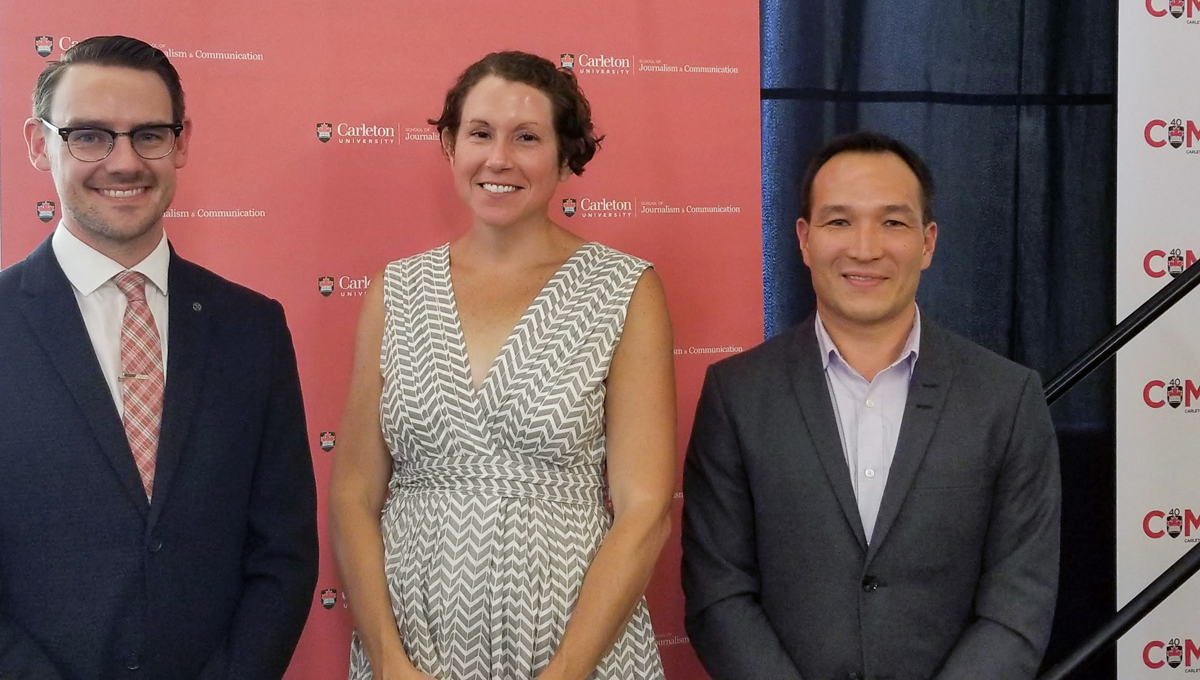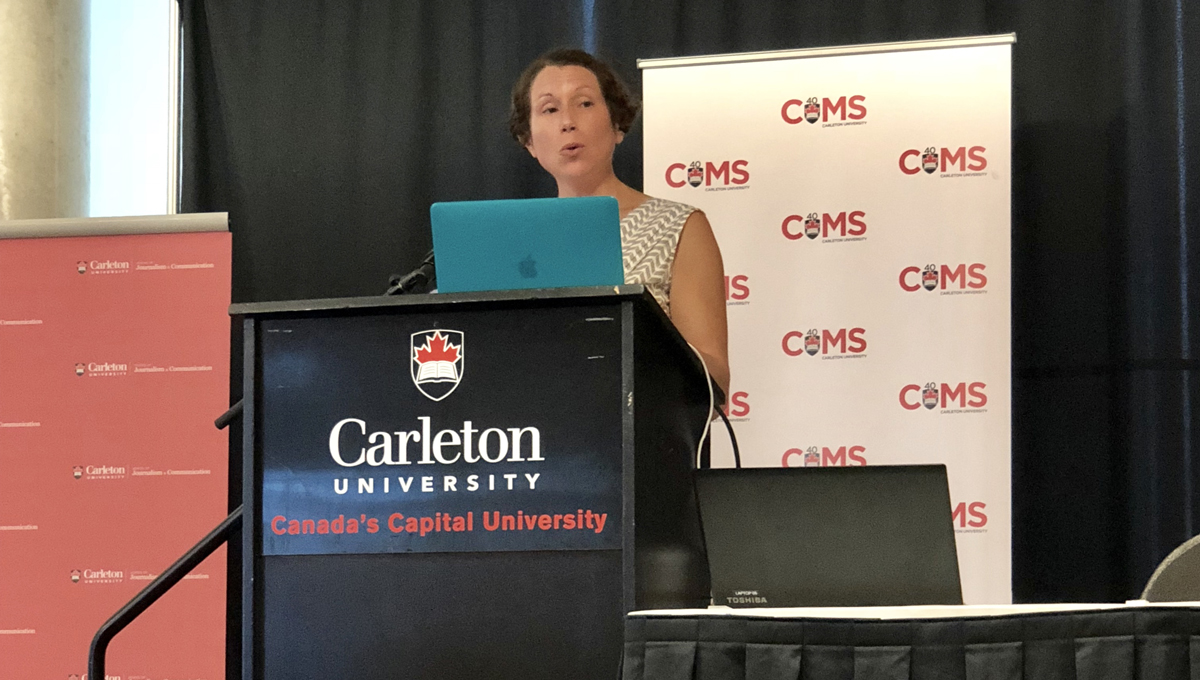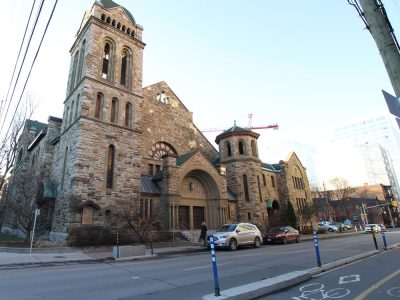By Joseph Mathieu
“If it ain’t broke, don’t fix it,” is a maxim in need of repair.
The longer the wait for things to break, the harder and more expensive they become to fix. But why is that common sense so uncommon?
In celebration of 40 years of Communication and Media Studies at Carleton University, the CoMS40 Anniversary Symposium sought to explore this question and many others involving the themes of history, theory, archives and archaeology.
Shannon Mattern, professor of Media Studies at The New School in New York City, closed out the day-long conference on Sept. 14, 2018 with a keynote lecture – Amending Care: An Archaeology of Maintenance.
She was introduced by Liam Cole Young, a faculty member at Carleton’s School of Journalism and Communication who praised her as a crucial feminist voice within media archaeology.

From left to right: Prof. Liam Cole Young, Prof. Shannon Mattern, and Prof. John Shiga
“[Her] attentiveness to the human side of infrastructure no doubt arose from Shannon’s early work on libraries,” Young said in his introductory remarks, “It has remained the common thread throughout her entire body of work.”
Shining a Light on Practices of Maintenance
Mattern’s lecture shone a light on historical and present-day practices of maintenance, as well as recent studies across several academic disciplines, from urban infrastructure to critical data studies. The diversity of research in fields like urban studies, anthropology, architecture, economics and media studies could help with the creation of robust and much-needed strategies for repair, she said.
By studying women’s roles in domestic and reproductive work alongside information, design and conservation work, Mattern appealed for a better understanding of maintenance work.
Perhaps few people today would imagine fixing their own washing machine, but there was a time, Mattern pointed out, when university-based home economics and domestic science programs taught women how to maintain their cooking and cleaning tools while caring for the home.
Care, defined by the scholars Joan Tronto and Berenice Fisher, is everything done to maintain, continue and repair the world to be able to live in it as well as possible. The upkeep of supply chains, the repair of instruments, the cleaning of datasets and the stewardship of social infrastructures all require care.
Today, homemakers rarely know how to repair tools they use every day. Breakdowns of home appliances typically require complicated diagnostics and specialized repair that often seems designed to keep consumers in a constant cycle of upgrades.
Ryerson University Prof. John Shiga, an alumni of Carleton’s PhD Communication program and Mattern’s respondent, said the lecture called for a new model of object repair governance, “not based so much on control, but on the notion of stewardship.”
The repair of urban infrastructure unfortunately fares no better. Maintenance might not be as highly valued as innovation, but ignoring it will only make things worse. In their 2017 infrastructure report card, the American Society of Civil Engineers gave water treatment, bridges, dams, transit, and roads in the United States an overall D plus.
“Why are we in this predicament?” technology historians Andrew Russell and Lee Vinsel wrote in The New York Times last year. “Americans have an impoverished and immature conception of technology, one that fetishizes innovation as a kind of art and demeans upkeep as mere drudgery.”

Despite the fact that deferred maintenance becomes more expensive as systems deteriorate further and become a debt burden for future generations, elected officials are under constant pressure to add programs and build new facilities. Repair projects are seen as costly afterthoughts, and the work of maintainers isn’t properly recognized.
“As Scott Gabriel Knowles proposes, and as Flint’s tainted water demonstrates, deferred maintenance might be the equivalent of slow disasters,” said Mattern. “Given the volume and severity from recent ruptures, from dams to data brokers, the whole world has shown itself to be a big tangle of rickety systems.”
Real and Digital Worlds in Similar Predicments
Clean water has yet to return to Flint, Michigan. Electricity was finally restored to Puerto Rico 11 months after Hurricane Maria. New York City’s public housing and transit systems are in a serious state of disrepair. The digital world is just as dilapidated – hacked accounts, unguarded personal data, missing information and election-tampering trolls are all symptoms of broken infrastructures.
“Every day, a new debacle,” said Mattern.
She warned that some outspoken technologists are too quick to propose whole new systems — like hyper-fast underground tunnels to beat car traffic, or putting the American library system under Amazon’s jurisdiction. And while it’s true that code has become increasingly important in architecture and city building, to label the digital revolution as strictly innovative is misleading.
According to historian Nathan Ensmenger, from the early 1960s to the present, between 50 and 70 per cent of software expenses have been for maintenance.
“In an industry that seems to exemplify all the promises of innovation and disruption, most of its coders are actually just fixing stuff,” said Mattern.
Functional infrastructure shouldn’t simply be discarded for something new or exciting. Even an army of repair robots will need “industrial hygienists,” she said, and datasets will still need curators, just as difficult, dirty work will require skilled labourers.
The work of housekeepers, librarians and data archivists is too often seen as vocational, and they are expected to do more with less. The western world needs to recognize and better support critical work performed by the world’s maintainers, including sanitation workers, teachers, social workers, and therapists.
“If care were a framework of analysis and imagination,” she said, “perhaps we could imagine a more equitable and responsible infrastructure.”
Wednesday, September 19, 2018 in Communications and Media Studies, Faculty of Public and Global Affairs
Share: Twitter, Facebook



